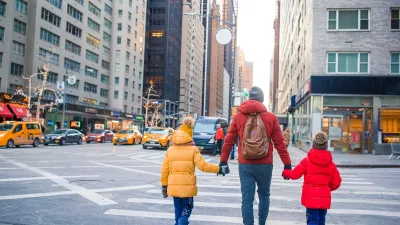City planners should be wary of any predictions that downplay the unknowability of the future by projecting present conditions onto it.
Envisioning cities of the future can sometimes be more at home in science fiction than urban planning. Optimism generally looms large in these visions. At the 1939 World’s Fair, the exhibit, “World of Tomorrow”—with its motto “For Peace and Freedom”—featured an elaborate futuristic model city called Democracity, a tribute to the reigning techno-utopian hopes of the time. Millions of visitors were awed by it. In a dark twist of irony, the model was melted down only a few years later to provide four thousand tons of steel for making bombs in World War II. This was only one of many 20th century futuristic urban visions that failed to materialize.
The New York Times columnist and George Mason economist Tyler Cowen has produced a vision that no one can accuse of being techno-utopian. In Average is Over: Powering America Beyond the Age of the Great Stagnation, Cowen sees reason for cities to accept some grim realities of the present as they plan for their future.
Cowen’s argument centers on the labor market. He points out that technological development and increasing foreign competition have decreased the demand for middle-wage workers. For the last twenty years in the U.S. as well as sixteen European countries, low-wage occupations rose as a share of the total labor market while middle-wage occupations declined. The recent 2008-2009 recession only solidified this reality, as many of the middle-wage jobs were replaced by new low-wage jobs.
FULL STORY: The Hazards of Predicting the Future of Cities

Alabama: Trump Terminates Settlements for Black Communities Harmed By Raw Sewage
Trump deemed the landmark civil rights agreement “illegal DEI and environmental justice policy.”

Planetizen Federal Action Tracker
A weekly monitor of how Trump’s orders and actions are impacting planners and planning in America.

The 120 Year Old Tiny Home Villages That Sheltered San Francisco’s Earthquake Refugees
More than a century ago, San Francisco mobilized to house thousands of residents displaced by the 1906 earthquake. Could their strategy offer a model for the present?

Ken Jennings Launches Transit Web Series
The Jeopardy champ wants you to ride public transit.

BLM To Rescind Public Lands Rule
The change will downgrade conservation, once again putting federal land at risk for mining and other extractive uses.

Indy Neighborhood Group Builds Temporary Multi-Use Path
Community members, aided in part by funding from the city, repurposed a vehicle lane to create a protected bike and pedestrian path for the summer season.
Urban Design for Planners 1: Software Tools
This six-course series explores essential urban design concepts using open source software and equips planners with the tools they need to participate fully in the urban design process.
Planning for Universal Design
Learn the tools for implementing Universal Design in planning regulations.
Clanton & Associates, Inc.
Jessamine County Fiscal Court
Institute for Housing and Urban Development Studies (IHS)
City of Grandview
Harvard GSD Executive Education
Toledo-Lucas County Plan Commissions
Salt Lake City
NYU Wagner Graduate School of Public Service





























